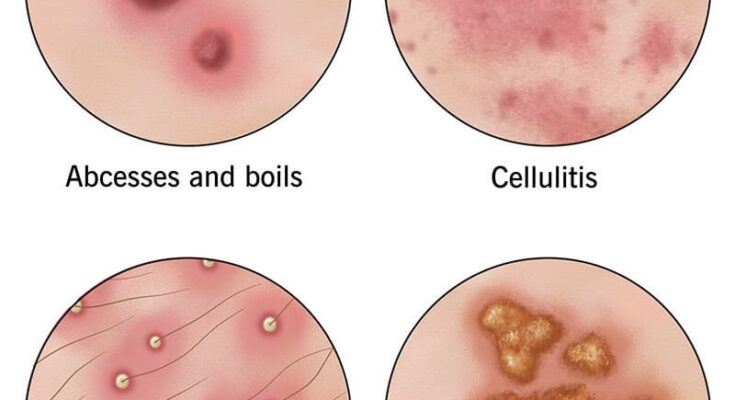Staphylococcus aureus, often called staph, is a type of bacteria commonly found on the skin and in the nose of healthy individuals. While it is usually harmless, it can cause various infections ranging from mild skin irritations to life-threatening conditions if it enters the body through cuts, wounds, or other openings.
Overview
Staphylococcus aureus is a gram-positive bacterium responsible for a wide range of infections. While some staph infections are superficial, others can become invasive, affecting deep tissues, the bloodstream, or vital organs. Certain strains, like MRSA (Methicillin-Resistant Staphylococcus aureus), are particularly concerning due to their resistance to antibiotics.
What Parts of Your Body Are Affected by Staph Infections?
Staph infections can affect nearly any part of the body, including:
- Skin and Soft Tissues: Boils, abscesses, impetigo, cellulitis.
- Respiratory System: Pneumonia caused by staph entering the lungs.
- Cardiovascular System: Endocarditis (infection of the heart valves).
- Bones and Joints: Osteomyelitis or septic arthritis.
- Bloodstream: Bacteremia, leading to sepsis if untreated.
- Urinary Tract: Infections caused by staph spreading internally.
How Common Is Staph Infection?
Staph infections are common worldwide, with Staphylococcus aureus being a leading cause of both healthcare-associated and community-acquired infections. According to studies:
- About 30% of people carry staph bacteria in their noses without symptoms.
- Infections are more frequent in people with weakened immune systems, those who have undergone surgery, or individuals using invasive medical devices.
Symptoms and Causes of Staph Infections
Symptoms:
Symptoms vary depending on the site and severity of the infection:
Skin Infections:
- Redness, swelling, and warmth around the affected area.
- Painful boils or abscesses filled with pus.
- Blister-like sores (impetigo)
Systemic Infections:
- Fatigue and muscle pain.
- Rapid heart rate or low blood pressure (sepsis).
- High fever and chills.
Specific Symptoms:
- Joint pain and swelling in septic arthritis.
- Difficulty breathing in staph-induced pneumonia.
Causes:
Staph infections occur when the bacteria penetrate the skin or mucous membranes due to:
- Cuts, scrapes, or surgical wounds.
- Medical devices like catheters or prosthetics.
- Compromised immunity (e.g., diabetes, cancer).
- Overuse of antibiotics, leading to resistant strains like MRSA.
How Do People Get Staph Infections?
Direct Contact:
- Skin-to-skin contact with an infected person.
Contaminated Surfaces:
- Gym equipment, shared towels, or other items.
Invasive Medical Devices:
- IV lines, catheters, or surgical implants.
Food Contamination:
- Eating food prepared by someone with staph bacteria on their hands.
Diagnosis and Tests
How Do I Know If I Have a Staph Infection?
To confirm a staph infection, doctors may:
- Examine Symptoms: Check for redness, swelling, and discharge.
- Order Lab Tests:
- Blood Tests: To identify bacteremia.
- Culture Tests: Swabbing infected areas or testing fluid/pus.
- Imaging Tests: X-rays or CT scans for deeper infections.
Management and Treatment of Staph Infections
Antibiotics:
- Oral or IV antibiotics depending on the infection’s severity.
- MRSA infections may require specific antibiotics like vancomycin.
Drainage:
- Surgical drainage of abscesses or pus-filled areas.
Supportive Care:
- Pain relief, hydration, and wound care.
How Long Is Staph Infection Contagious?
Staph infections are contagious as long as the bacteria are present in the infected area or until the wound heals completely. Proper hygiene and prompt treatment reduce the risk of spreading.
Complications Associated with a Staph Infection
If untreated or poorly managed, staph infections can lead to severe complications, such as:
- Sepsis: A life-threatening response to infection.
- Organ Failure: If bacteria spread to vital organs like the heart or kidneys.
- Toxic Shock Syndrome: A rare but fatal condition caused by staph toxins.
- Chronic Infections: Persistent or recurring infections, especially in joints or bones.
Stem Cell Therapy for Staph Treatment
Stem cell therapy is an emerging approach in managing bacterial infections, including staph. Stem cells have unique properties that can help:
- Enhance Immune Response: Stimulate the body to fight bacterial infections.
- Reduce Inflammation: Aid in healing by minimizing tissue damage.
- Regenerate Damaged Tissues: Repair areas affected by chronic staph infections.
SPIDEX19 and Faforon: Stem Cell Treatments for Staph Infections
SPIDEX19:
- A cutting-edge supplement designed to boost the body’s natural production of stem cells.
- Helps regenerate damaged tissues and strengthen the immune system.
- Reduces inflammation and supports faster recovery from infections.
Faforon:
- A powerful herbal-based stem cell activator.
- Promotes immune system function, aiding in the elimination of bacterial infections.
- Supports overall healing and enhances tissue regeneration.
Benefits of SPIDEX19 and Faforon for Staph Treatment:
- Non-invasive and safe for long-term use.
- Complements traditional treatments like antibiotics.
- Speeds up recovery by addressing both the symptoms and root causes.
Conclusion
Staphylococcus aureus infections can range from mild skin issues to severe systemic illnesses. Understanding the symptoms, causes, and treatment options is crucial for early diagnosis and effective management. While traditional antibiotics remain essential, advanced therapies like stem cell treatments offer promising solutions for combating infections and promoting healing.
Supplements like SPIDEX19 and Faforon represent a new frontier in staph treatment, harnessing the power of stem cells to enhance the immune system and repair damaged tissues. By combining these innovative approaches with proper hygiene and medical care, individuals can effectively manage staph infections and reduce the risk of complications.



